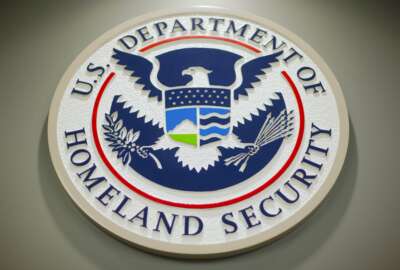Sponsored by Granicus
DHS’ new directorate is on a mission to ‘CX all the things’
After its official launch in July, the Department of Homeland Security’s new Customer Experience Directorate sees technology as the pathway to a more...
Transportation Security Administration. Federal Emergency Management Agency. U.S. Citizenship and Immigration Services. Customs and Border Protection — each of these four agencies have very different missions, but they all share one thing in common: they’re top priorities within the Department of Homeland Security’s lofty goals to improve its near-constant interactions with the public.
Efforts to improve customer experience are certainly not unique to DHS — in fact, all agencies now have higher expectations after the Biden administration created an executive order on customer experience in 2021. But DHS is a rare case, since its components interact with the public on a daily basis more than any other federal agency.
To help handle the massive amount of public interaction, DHS launched a new initiative, called the Customer Experience (CX) Directorate, which aims to synthesize, manage and majorly improve customer experience in those four key high-impact service providers — TSA, FEMA, USCIS and CBP — all housed under the department’s broad umbrella of components.
“While the executive order catalyzed that, now we’re in a place where everybody across the department is seeing the benefits of really understanding customer needs and designing proactively better experiences for better outcomes for them,” Dana Chisnell, the directorate’s executive director, told Federal News Network. “There are pockets of CX happening in lots of different places in each of the components, and now the discussion is, ‘Where will it live? Where will it be centralized?’”
That central location is the CX Directorate. After getting the official agency sign-off in July to launch the initiative, the directorate, composed so far of roughly 20 employees, is now tasked with leading the department’s activities in design and experience operations; policy, guidance and data; community engagement and partnerships; plain language and language access; and service delivery.
“We’re really here to inject customer experience design, human-centered design, product management, digital services and skills into everything across the department from service delivery to acquisitions and procurement,” Chisnell said. “What does it look like to have requirements in every contract, and evaluation criteria for every acquisition, that includes CX position descriptions, how human resources interacts with candidates and more?”
Chisnell said the overarching goal is to make customer experience at DHS more “human-centered” — but what that means can be very different, depending on the component and the individual customer interaction. But overall, Chisnell wants leaders at TSA, FEMA, USCIS and CBP to answer two main questions.
“One is, what is the outcome that we want for the public? And the second one is, what’s the experience that we want them to have in getting there?” she said. “If you think about the holistic experience that somebody has with the government, that journey starts and ends with the specific touchpoints that people have with us.”
And those touchpoints are key to improving the public’s interactions with DHS. It all comes down to focusing on what’s happening with the customer, each step of the way.
“What are they experiencing? How are they feeling about it? Do they understand what’s going on? We want to find out what their situation is, and take action on it,” Chisnell said.
After a customer submits their application for TSA Pre-Check, for example, they often encounter a long waiting period, where they may not know the next step, or how long it will take to hear back. During that time, there’s a lot happening behind the scenes, but from the customer end, it can feel like a black hole. That’s one area Chisnell is hoping to change, by providing more up-to-date feedback to customers.
“We now have more data where we can say what to expect,” she said. “When you get the confirmation from Pre-Check, they can give you an indication that the application will take two to three weeks, or two to three months, depending on what the backlog looks like. Setting those expectations is part of the relationship that we have with a customer.”
Technology is also a massive part of the CX Directorate, as well as Chisnell’s long-term goals for improving the public’s interactions with the department. Although the directorate’s main approach is human-centered, technology underpins practically every interaction anyone will have with DHS — and the two go hand in hand.
“It should not be technology-focused, but it is enabled by technology,” she said. “In a naturalization interview with an immigration officer, that officer is using technology, and the applicant may be signing off on an iPad. But we want the focus in that interaction to be the human connection, not time and energy focused on what the tools and the technology are.”
Beyond making customer experience more human-centered, the next step for DHS is gathering feedback from the public about their experience.
Grabbing data from the interaction with the customer as soon as possible is crucial. The goal is to meet the customer right at the transaction point, usually on a digital platform, to ask for feedback about the experience, Chisnell said.
TSA, for instance, recently ran an experience survey across about a dozen airports this past spring. The agency collected responses from 13,000 people, but they’re still working on what those responses actually mean — and how to use that information in the long-run. For Chisnell, it’s an opportunity to see what comes next for customer experience. That data should be continuously collected, analyzed, used to make improvements and then shown back to the public.
“One of the things that we’ll be working on with our partners in the components is, what happens with that data? How is it tracked, accounted for and then turned into feedback, turned into solutions to challenges and problems that customers are having?” she said. “And then, how do we communicate that out? Services make improvements all the time. But they don’t always publicly say they’re improving because they got feedback. We’re going to be working on all those kinds of things.”
The bottom line? Chisnell said, “we’re on a mission to CX all the things.”
Copyright © 2025 Federal News Network. All rights reserved. This website is not intended for users located within the European Economic Area.
Drew Friedman is a workforce, pay and benefits reporter for Federal News Network.
Follow @dfriedmanWFED






